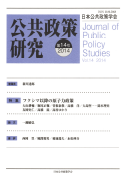Volume 14
Displaying 1-17 of 17 articles from this issue
- |<
- <
- 1
- >
- >|
Preface
-
2014Volume 14 Pages 2-3
Published: December 20, 2014
Released on J-STAGE: June 08, 2019
Download PDF (270K)
Special Issue: Nuclear Power Policy after Fukushima
-
2014Volume 14 Pages 4-5
Published: December 20, 2014
Released on J-STAGE: June 08, 2019
Download PDF (270K) -
2014Volume 14 Pages 6-23
Published: December 20, 2014
Released on J-STAGE: June 08, 2019
Download PDF (6802K) -
2014Volume 14 Pages 24-36
Published: December 20, 2014
Released on J-STAGE: June 08, 2019
Download PDF (1600K) -
2014Volume 14 Pages 37-50
Published: December 20, 2014
Released on J-STAGE: June 08, 2019
Download PDF (1778K) -
2014Volume 14 Pages 51-64
Published: December 20, 2014
Released on J-STAGE: June 08, 2019
Download PDF (1810K) -
2014Volume 14 Pages 65-77
Published: December 20, 2014
Released on J-STAGE: June 08, 2019
Download PDF (1647K) -
2014Volume 14 Pages 78-85
Published: December 20, 2014
Released on J-STAGE: June 08, 2019
Download PDF (1054K) -
2014Volume 14 Pages 86-98
Published: December 20, 2014
Released on J-STAGE: June 08, 2019
Download PDF (1735K) -
2014Volume 14 Pages 99-108
Published: December 20, 2014
Released on J-STAGE: June 08, 2019
Download PDF (1359K)
Articles
-
2014Volume 14 Pages 109-124
Published: December 20, 2014
Released on J-STAGE: June 08, 2019
Download PDF (2131K)
Book Reviews
-
2014Volume 14 Pages 125
Published: December 20, 2014
Released on J-STAGE: June 08, 2019
Download PDF (127K) -
2014Volume 14 Pages 126
Published: December 20, 2014
Released on J-STAGE: June 08, 2019
Download PDF (121K) -
2014Volume 14 Pages 127
Published: December 20, 2014
Released on J-STAGE: June 08, 2019
Download PDF (133K) -
2014Volume 14 Pages 128
Published: December 20, 2014
Released on J-STAGE: June 08, 2019
Download PDF (120K)
-
2014Volume 14 Pages 129-131
Published: December 20, 2014
Released on J-STAGE: June 08, 2019
Download PDF (351K) -
2014Volume 14 Pages 132-133
Published: December 20, 2014
Released on J-STAGE: June 08, 2019
Download PDF (142K)
- |<
- <
- 1
- >
- >|
